08.09.2006
M.Notkin. Unbearable Heaviness of Rook
Hot guys fought hard in the heat of July. And, to be accurate and consistent, hot girls fought, too. Some experts noted that the selection is generally not very impressive, but I will try to annotate it to reverse that impression. There is something curious in each of the encounters above.
Wang Hao – G.Vescovi
China
1.e4 c5 2.¤f3 e6 3.d4 cxd4 4.¤xd4 a6 5.¤c3 d6 6.Ґe3 b5. Strict and attentive reader may ask – is mister grandmaster going to develop his pieces, or he`ll just keep pushing pawns? Let me reassure you – it will take a while for the next pawn move to be made.
7.f3. For 7.g4 refer to the next game.
7...Ґb7 8.Јd2 ¤d7 9.g4. After 9.0-0-0 ¤gf6 10.g4 ¤b6 awell-knownpositionisreachedviaatransposition. Now the Black`s knight cannot easily land on f6.
9...¤e7 10.0-0-0. In Brendel-Meiers, Lausanne 2005, this position occurred with White to move, as the Latvian grandmaster hesitated about the optimal placement of his b-pawn, and played b7-b6 first. Characteristically, it did not prevent him from winning the game.
10...¤c6 11.¤xc6 Ґxc6 12.g5.
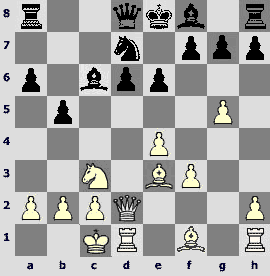
The diagrammed position can be reached in a more usual way of handing the knights: the Queen`s knight goes to c6 and exchanges, and the King`s knight develops to f6 and retreats to d7 after g4-g5.
White got an advantage in Chandler-J.Howell, London 1985, after 12...Ґe7 13.h4 0-0 14.h5 ¤e5 15.f4 b4 16.¤d5! (try memorizing this position until the next diagram appears, and we`ll discuss everything about the moon and new ideas) 16...exd5 17.exd5.
12...Јc7 looks the most solid option, for example, 13.h4 ¦c8 (in Jenni-Hort, Switzerland 2004, the players agreed to a draw after 13...¤b6 14.h5 ¦b8 15.Ґxb6 ¦xb6 16.¤e2 d5 17.Јc3 b4, but White`s 15th move is questionable) 14.a3 Ґb7 15.Ґd4 ¤e5 16.Јe3 ¤c4 17.Ґxc4 Јxc4, and Black has a good game, Short-Ribli, Montpellier 1985.
12...Јa5 13.ўb1 ¦b8 14.h4 ¤e5 15.f4 b4. After 15...¤c4 16.Ґxc4 bxc4 17.Јd4 Јb4 18.Ґc1 Black fails to create any serious threats, and suffers due to underdeveloped kingside. 15...¤g4 is met by 16.Ґh3, too, but this is probably the most appropriate course for Black. After exchanging on е3 he could offer to swap the queens by Јb6. The text-move provokes a tactical conflict.
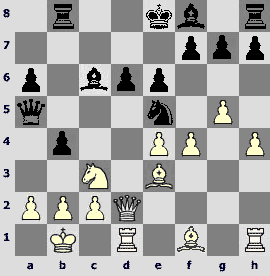
16.¤d5! ¤g4. Nothing has changed in twenty-plus years – the position after 16...exd5 17.exd5 favors White. Toobadis 16...¤f3? 17.Јe2, but 16...¤d7 is probably more cautious.
17.Ґh3 h5?! Let us play 17...¤xe3 18.Јxe3 ўd8 and compare this position with those occurred in the game after 19...ўd8. White kept an active bishop on e3, and the rook moved to a central file, while the Black`s knight became more passive. Maybe, Vescovi was worried about 19.Јa7, but after 19...¦b7 20.Јa8+ ўd7 White does not manage creating threats in time, and has to take a draw, if the opponent agrees, for instance, 21.h5 ¦c7 22.Јb8 ¦b7 23.Јa8 ¦c7; and, secondly, one can reject 18...ўd8 in favor of the prophylactic 18...¦b7.
18.gxh6 ¤xh6 19.¦he1 ўd8 20.Ґa7. An elegant move, however, a piercing 20.f5! exd5 21.f6 is a good alternative.
20...¦b7. The bishop must be attacked. Indifferent 20...¦b5 21.Јe3 drops an exchange, because 21...exd5 22.exd5 Ґxd5 23.Јe8+ ўc7 24.Јc8 is a checkmate.
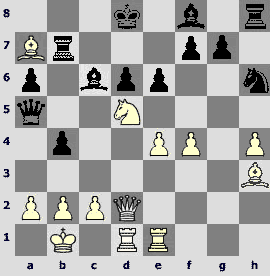
It is already the time to post a new diagram, and the knight is still there. However, it falls on the next move.
21.Јe3 exd5 22.exd5 Ґb5. 22...Ґa4 23.b3 Ґb5 24.Ґd4 does not change much.
23.Ґd4 Јc7? White`s energetic reply suddenly demonstrates that the c-pawn is mined. One had to play 23...f5, neutralizing the light-squared bishop. It gives up the e6-square, but there is nothing forcing – the position remains playable.
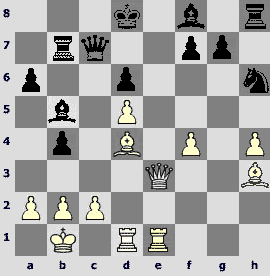
24.c4! Ґd7. A triple spell is cast on the с4-pawn. The bishop cannot take it, you`ve guessed it right, because of the mate in one; I can tell that 24...Јxc4 25.¦c1 Јd3+ 26.ўa1 is mate in 8; and Black even cannot enjoy taking it en passant, since 24...bxc3? 25.¦c1 leaves the с8-square prone, and the counter-attack 25...Ґd3+ 26.Јxd3 ¦xb2+ 27.ўa1 yields nothing – 27...¦xa2+ 28.ўxa2 Јa5+ 29.ўb3 or 27...Јa5 28.Јc4.
25.Ґxd7 Јxd7 26.Ґb6+ ўc8 27.c5! This emphatic breakthrough creates a central passed pawn for White, which makes his task significantly easier, compared to the variation 27.Јe8+ Јxe8 28.¦xe8+ ўd7 29.¦d8+ ўe7 30.¦e1+ ўf6 31.Ґd4+ ўf5 32.¦ee8 ўxf4 33.¦xf8 ¦xf8 34.¦xf8 ¤f5. Everything is forced now till the next diagram.
27...dxc5 28.Јe8+ Јxe8 29.¦xe8+ ўd7 30.¦d8+ ўe7 31.d6+.

31...ўe6?! Black could put up more resistance by 31...ўf6. 32.Ґxc5 is replied by unpretentious 32...¦g8, and White has to continue his positional attack in the ending without a piece by 33.h5!, as 33.d7? Ґxc5 34.¦xg8 ¦xd7! gives the opponent an edge. Straightforward 32.d7 is the best, and after 32...¦xb6 33.¦e8 Ґe7 34.¦xh8 White wins an exchange and obtains winning chances, e.g., 34...¤f5 35.d8ЈҐxd8 36.¦dxd8 ¦e6 37.¦de8 or 34...ўf5 35.d8ЈҐxd8 36.¦hxd8 ўxf4 37.¦8d5, but Black can continue resisting.
32.d7 Ґe7. 32...ўf5 is less effective without a pawn and a tempo – 33.Ґxc5 Ґxc5 34.¦xh8 Ґe7 35.d8ЈҐxd8 36.¦hxd8 ўxf4, but now the game ends instantly.
33.¦xh8 ¦xd7. In case of 33...¦xb6 White wins an exchange under especially favorable circumstances – 34.¦e8! ¦d6 35.¦xe7+ ўxe7 36.¦xd6.

34.¦xh6+! A very cute finishing blow on a theme of destroying the defender and distraction. Black resigned, in view of 34...gxh6 35.f5+.
The notes to the next game are written by Mikhail Golubev (Chess Today).
J.-М.Degraeve – V.Meiers
France
Jean-Marc Degraeve, a dangerous and exceptionally aggressive player, took a clear first in Saint-Chelyd'Aubrac open. His victory over the other contender, Viesturs Meiers, creates a strong impression.
1.e4 c5 2.¤f3 e6 3.¤c3 a6 4.d4 cxd4 5.¤xd4 d6 6.g4!? b5 7.Ґe3. A rare continuation in a rare variation! 7.a3 occurred in Short-Kasparov, Amsterdam 1994, and 7.Ґg2 was played in Ponomariov-Milov, Torshavn 2000.
7...b4!?N Why not?
8.¤a4 Ґb7 9.Ґg2 ¤f6!? 10.g5!
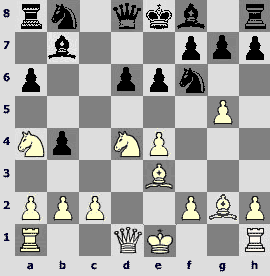
10...¤xe4. Already this capture is fairly risky. 10...Ґxe4? is obviously bad: 11.gxf6 Ґxg2 12.¦g1 Јxf6 13.¦xg2. However, I think many grandmasters would prefer 10...¤fd7.
11.Јg4! d5. Not 11...¤c5? 12.¤xc5 dxc5 13.Ґxb7 cxd4 14.Јxd4. Also bad is 11...Јa5? due to 12.¤xe6! (this is stronger than 12.Ґxe4 Ґxe4 13.Јxe4 d5!).
12.Ґxe4! dxe4 13.0-0-0. Now it is not easy for Black to parry all threats.
13...Ґd5. An alternative is 13...¤d7 14.g6! with possible follow-up 14...f5 (14...Ґd5 returns us to 13...Ґd5 14.g6 ¤d7) 15.¤xf5 exf5 16.Јxf5 Јe7, and here instead of 17.Ґc5 ¤xc5 18.¤xc5 hxg6 19.Јxg6+ Јf7 20.Јxf7+ ўxf7 21.¤xb7 (where Black seems to hold in a worse ending), 17.Ґg5!? is more dangerous.
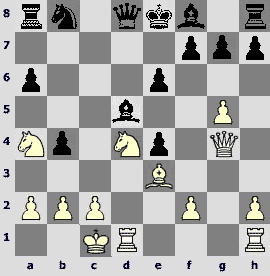
14.¤xe6!? White was not forced to continue his attack in spectacular style. 14.g6 is an obvious alternative: 14...¤d7 (14...hxg6 15.¤xe6!±) 15.gxf7+ ўxf7 16.f3 ¤f6 17.Јh3 with compensation. There is also a more complicated possibility – 14.f3!? exf3 15.g6, and Black is forced to play 15...hxg6 (as 15...¤d7 16.gxf7+ ўxf7 17.¤xf3! looks disastrous) 16.¤xe6, albeit after 16...Јd7! with the idea 17.¤c7+ Јxc7 18.¦xd5 ¤c6 White has a problem with a finishing blow.
14...fxe6 15.¤b6.
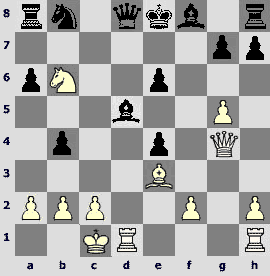
15...¤c6. I also analyzed 15...Ґe7!, which is probably stronger: 16.g6!? (the Black`s idea is justified by 16.¤xa8 ¤d7!) 16...¤d7!? (16...h5!? 17.Јh3! ¦f8!? 18.Јxh5 ¤d7 19.¤xd5 exd5 20.Јxd5 leads to an unclear game, unlike 16...¤c6?! 17.¤xd5!? exd5 18.Јe6 Јc8 19.Јf7+ ўd7 20.Ґb6! and White is attacking; clearly inferior is 16...0-0? 17.¤xd5 exd5 18.Јe6+ ўh8 19.¦xd5+- as well as 16...h6? 17.¤xd5 exd5 18.Јe6!+-) 17.¤xd5 (ofcourse, 17.¦xd5!? exd5 18.¤xd5 looks cute, but the game is actually double-edged: 18...0-0!? 19.Јe6+ ўh8 20.¤xe7 ¦e8 21.Ґg5 b3! 22.gxh7 bxa2 23.Јxa2 Јb6) 17...exd5 18.Јe6 (or 18.¦xd5 Јc7) 18...hxg6, and I did not find anything more promising than 19.¦xd5 Јc7 20.Јxg6+ ўf8 21.¦g1 Ґf6 22.¦xd7 Јxd7 23.Ґc5+ ўg8 24.Јxf6 with mutual chances. Black is worse after 18...¤f6 19.Јf7+ ўd7 20.¦xd5+ ¤xd5 21.Јxd5+.
Immediate 15...¤d7? 16.¤xd5 exd5 17.¦xd5 also leads to a dangerous position.
16.¦xd5 exd5 17.Јe6+ ¤e7 18.¦d1.

18...¦b8. If 18...¦c8!?, White continues 19.¦xd5 Јc7 20.¦c5! (20.¤xc8 Јxc8 21.Јxe4 Јc6! 22.¦e5 Јxe4 23.¦xe4 succumbs an advantage, and 20.Ґc5 is met by 20...Јc6!) 20...Јxc5 21.Ґxc5 ¦xc5 22.¤c4!, and Black is in trouble due to the enemy queen`s activity. If 22...¦c6 23.¤d6+ ўd8 24.¤f7+ ўe8, then White avoids the repetition by 25.Јb3! ¦g8 26.¤e5.
19.¦xd5 Јc7 20.¦e5!? Another interesting idea is 20.b3!? (preparing ¤c4). Black`s best response is probably 20...Јc6!? (20...¦g8 21.¤c4 Јc6 22.¤d6+ ўd8 23.¦d4!+- or 20...¦xb6 21.Ґxb6± favor White) 21.¦d6, and now 21...Јc7 (21...Јc3 22.¤c4!).
If White wants to avoid 22.¦d5= (which is understandable!), he can play 22.¤d5!? Јc8 23.Јxe4 with compensation. These are some illustrative lines: 23...ўf7 (23...Јf5? 24.¤c7+ ўf7 25.Јc4+) 24.Ґb6!? ¦b7 25.¤xe7! Ґxe7 (25...¦xe7 26.Јd5+ ¦e6 27.Јf5+ ўe7 28.Ґc5!+-) 26.¦c6! Ґxg5+ (26...Јd7 27.Јc4+! ўe8 28.¦c8++-) 27.f4!? Јxc6 28.Јxc6 Ґxf4+ 29.ўb1 ¦hb8 30.Јc4+ with White`s advantage in the endgame due to precarious position of the Black`s king.
20...¦d8? Black commits a grave error. He had to play 20...¦xb6 21.Ґxb6 Јd7, although after 22.Јc4 the defender`s task is far from being simple – Black has an extra knight, but his pieces are tied up. In case of 22...Јg4 White can calmly proceed with 23.Ґe3!? etc.

21.¦f5! Black resigns, in view of 21...¦d6 (21...¦d1+ does not help: 22.ўxd1 Јc6 23.Јe5!?) 22.Јf7+ ўd8 23.Јxf8+! ¦xf8 24.¦xf8 ischeckmate.
You may say – everybody can attack a king stuck in the center. Well, here`s another game, featuring an attack against a well-supported king.
F.Jenni – R.Forster
Switzerland championship
Florian Jenni took the first place in the championship of Switzerland, surpassing Victor Lvovich as well as creator of the best game of July. So Florian can`t complain about sporting achievements, and here is his best creative achievement.
1.e4 c5 2.¤f3 d6 3.d4 cxd4 4.¤xd4 ¤f6 5.¤c3 a6 6.Ґe3 e5 7.¤b3 Ґe6 8.Јd2 Ґe7 9.f3 0-0 10.0-0-0 b5 11.g4 b4 12.¤d5 Ґxd5. Please let me skip some opening nuances. With the pawn on g4, taking with the knight is unfavorable for Black, because the bishop is deprived of the f5-square.
13.exd5 a5.

14.¤c5. This spectacular thrust is not the main continuation. More common is 14.ўb1 Јc7 (14...a4 15.¤c1 Јa5 16.g5 ¤fd7 17.h4) 15.g5 ¤fd7 16.h4 ¤b6 with mutual chances.
14...a4. Initially I wanted to make a banal comment about chess superiority over draughts, proven by 14...dxc5?! 15.d6 being better for White. Then I started thinking: if capture was mandatory in chess, 15.d6 would have been illegal. White had to choose between Bxc5 or Qxb4. So let us conclude that 14...dxc5?! 15.d6 is not good for Black, without any remarks offensive to draughts.
Black also tested 14...¤bd7 15.¤a4 ¦b8 (too passive 15...¤e8 16.h4 ¦b8 17.g5 g6 18.h5 ¤g7 19.Ґd3 ¤xh5 20.¦dg1 gives White strong initiative, Kobalia-Bruzon, Varadero 2000) 16.ўb1 ¦e8 17.h4 e4 18.g5 ¤h5 with lively and double-edged game, L.Guliev-Mitenkov, Moscow 1995 or 14...¤fd7 15.¤e4 Јc7 16.ўb1 ¤a6 17.h4 ¤ac5 with acceptable position, Zontakh-Reder, Budapest 1999.
15.g5 ¤fd7. A new retreat instead of 15...¤h5, which gives White an extra tempo after 16.¤e4 and ¤g3.
16.¤e4 Јa5. One has to consider 16...b3, but White`s strong centralization allows him to hope that opening the c-file is in his favor: 17.cxb3 axb3 18.a3 или 17.a3 bxc2 18.Јxc2.
17.Ґh3!? As the course of this game shows, White can go without a dogmatic 17.h4.
17...¤b6. This moves leaves the Black`s king almost defenseless. 17...Јb5 with the same idea of developing the knight to a6 was better.
18.ўb1. "A lazy move" (referring to Dr Nunn), as White could already start his combo – 18.¤f6+! ўh8 (18...gxf6? loses to 19.gxf6 Ґxf6 20.¦hg1+ ўh8 21.Ґxb6 Јxb6 22.Јh6 Јd8 23.Ґf5) 19.Јf2 gxf6 (if 19...¤c4?, then 20.Јh4 forking с4 and h7) 20.Ґxb6 Јb5, and now 21.f4 ¤d7 or 21.Ґf5 fxg5 22.h4 g4 leads to a very pleasant position for White, although there is no forced win to be found.
18...¤a6. More natural is 18...¤c4 19.Јd3 ¤xe3 20.Јxe3, reducing the number of attacking pieces, and only then – 20...¤a6. In case of 21.¤f6+, 21...gxf6? is still bad, but after 21...ўh8 Black is okay.
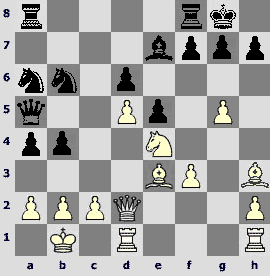
19.¤f6+! Jenni does not miss his second chance.
19...ўh8. Taking with the pawn is still impossible, and 19...Ґxf6 20.gxf6 ¤c4 21.Јd3 ¤xe3 22.Јxe3 is also unsatisfactory.
20.¦hg1. A practical man may say that White wins an exchange by 20.Ґxb6 Јxb6 21.¤d7. Probably this is the best move. Also tempting is 20.Јf2. Black cannot capture with the pawn – 20...gxf6 21.Ґxb6 Јb5 22.f4! and the attack is decisive, for example, 22...Јc4 (22...fxg5 23.fxe5+-) 23.gxf6 Ґxf6 24.fxe5 Ґxe5 25.¦d4! Јb5 26.Ґf5. However, after 20...¦fb8 21.Јh4 Ґxf6 22.gxf6 g6 23.Јh6 ¦g8 the position is far from being clear.
20...¤c5. 20...¤c4? 21.Јd3 gxf6 22.gxf6 Ґxf6 23.Јxc4 leads to a clear advantage for White.
21.¦g4.

21...b3? Switzerland, a Baron`s estate. Baron`s guest goes hunting in the forest, given a rifle and an escort hunter. The guest sees a pheasant, prepares to shoot, but the hunter tells him: "Please, don`t shoot, it is Elsa – favorite pheasant of Baron`s wife, Baron never fires at Elsa." They keep walking and see another bird. The guest is relaxed, but the hunter tells him: "Go ahead and shoot, it is Eduard, Baron always fires at Eduard."
I like this joke, and I think there is a better version with two tabooed pheasants, but I was lazy writing and just copied the text from the Net. However, the Net version adds Switzerland, which is a nice geographical reference to this game.
I included the joke to illustrate that the knight could finally be taken with the pawn – 21...gxf6 22.gxf6 Ґxf6 23.Ґxc5 Јxc5 24.Јh6 ¤d7 (the g4-rook has interposed the bishop, therefore Black has this defensive maneuver) 25.¦g3 (25.¦h4? does not work: 25...Ґxh4 26.Ґf5 ¤f6 27.Јxh4 ¦g8 28.Јxf6+ ¦g7) 25...¦g8 26.Ґxd7 Ґg7 or 26...¦xg3 27.hxg3 Ґg7, and Black manages to defend.
Another move deserving attention is 21...a3! White has to cut on his ambition – 22.¦h4? Ґxf6 23.gxf6 axb2 24.fxg7+ ўg8! 25.gxf8Ј+ ўxf8 checkmates his won king.
One can give up on mating and play 22.Јxb4, but here Black cannot complain, too – 22...gxf6 23.Јxa5 ¦xa5 24.b4 f5! (stronger than 24...¦b5 25.gxf6 Ґxf6 26.Ґf1 ¤ca4! 27.Ґxb5 ¤c3+ 28.ўc1 ¤xa2+ 29.ўd2 ¤xd5 30.Ґh6) 25.¦h4 ¦b5. The line 26.Ґf1 ¤ca4 27.Ґxb5 ¤c3+ 28.ўc1 ¤xa2+ 29.ўd2 ¤xd5 leads to Black`s advantage, and after 26.Ґxf5 compensation seems insufficient.
In the line 22.b3 gxf6 23.gxf6 Ґxf6 24.Ґxc5 Јxc5 25.Јh6 Black is saved by 25...¤d7, and in addition he threatens Јc3, while 26.¦c4 is met by 26...Ґg7!, and White loses a piece. He begins to complicate things – 27.Јg5 Јa7. In case of 28.Ґf5 e4 29.¦xe4 ¤e5 the knight goes to g6 and covers the king. Better is 28.¦h4, and after 28...f5 – not 29.Ґxf5 ¤f6 30.Јg6 h6, but 29.¦xh7+ ўxh7 30.Ґxf5+. Black has a draw, and it is unclear whether he is better after 30...ўg8 31.Ґe6+ ¦f7 32.¦g1 ўf8 33.Ґxf7 Ґf6 34.Јg6 Јd4 35.ўc1.
22.¦h4!? gxf6? No, this was again the favorite pheasant of the Baron`s wife. Also after 22...Ґxf6 23.gxf6 Јxd2 24.fxg7+ ўxg7 25.¦xd2 White has a clear plus. However, 22...h6! removes all crushing blows, and 23.Јxa5 bxc2+ (worse is 23...¦xa5?! 24.axb3 axb3 25.cxb3, and now 25...gxf6? loses to 26.¦xh6+ ўg7 27.gxf6+ Ґxf6 28.¦g1+) 24.ўxc2 ¦xa5 leads to a position full of life.

23.Јg2! Threatening 24.¦xh7+! ўxh7 25.Ґf5+, and White mates. On 23...fxg5 he wins by 24.¦xh7+! ўxh7 25.Ґf5+ ўh6 (25...ўg7 26.Ґxg5) 26.Јh3+ ўg7 27.Јh7+ ўf6 28.h4!
23...f5! Black prevented opening of the g-file, and pace of the attack decreases a bit.
24.Ґxf5 a3 25.cxb3 axb2.

26.¦a4!! A colossal sacrifice! The rook suddenly moves in a completely opposite direction. 26.¦xh7+ ўg8 27.¦h8+! ўg7! is only a perpetual check. Now White replaces the rook with the queen, and his threats become more dangerous.
26...¤cxa4 27.Јh3 ¤c3+ 28.ўc2! This had to be foreseen. 28.ўxb2?? loses to 28...Јxa2+ 29.ўxc3 ¦fc8+.
28...b1Ј+ 29.¦xb1 Јxa2+ 30.¦b2 Јxb2+ 31.ўxb2 ¦a2+.
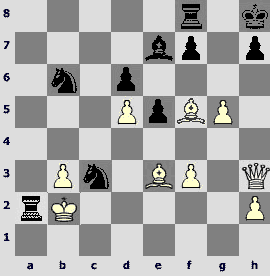
32.ўxc3. The computer says that retreating to с1 is finer, but the king apparently decided to take part in the battle.
32...¤xd5+ 33.ўd3 (33.ўc4?? ¤xe3+) 33...¤b4+ 34.ўe4! d5+ 35.ўxe5 ¤c6+ 36.ўxd5 (but not 36.ўf4?? Ґd6+ 37.ўg4 ¦xh2, and the queen cannot escape) 36...¦a5+ (36...¤b4+ 37.ўe4) 37.ўxc6. A brilliant sally has come to an end. The king defeated queen, two knight and a couple of pawns.
37...¦xf5 38.Јxf5. Blackresigns.
Sergey Ivanov commented the following game, which concludes our selection, as follows: "A brilliant positional game by Volodya Epishin. I think this game must be included in textbooks as a model example of playing against the King`s Indian, and, more precisely, of handling the positions with closed pawn center. Note Epishin`s order of actions: exchange 14.exf5 (to prevent Black`s attack after f5-f4), attack of the f5-pawn by 15.¤h4, 16.Ґd3 and 17.Јh5 (forcing to exchange queens), preventing Black`s counterplay on the queenside (21.b4 and 26.b5), preparation and undertaking of 29.f4, forcing the opponent to reply e5-e4 and trade the dark-squared bishops, while the White`s knight is already on a blockade square e3. Preparation and undertaking of 33.g4, and, finally, as all White`s pieces settled on the best squares, a small combination – 37.¤f5!!, followed by a king`s sally and finishing blow 48.¦h8! Black`s queen`s knight observed it from its initial square. What a lesson of positional play!"
These tracing notes made my work significantly easier.
V.Epishin-F. de la Paz
Barbera del Valdez
1.d4 ¤f6 2.c4 g6 3.¤c3 Ґg7 4.e4 d6 5.¤f3 0-0 6.Ґe2 e5 7.0-0 c6 8.¦e1 ¤a6 9.Ґf1 Ґg4 10.d5 ¤e8. More popular is 10...¤b4, and in view of Ґxf3 (positional threat!) White is forced to play 11.Ґe2, after which Black creates a barricade on the queenside by 11...a5.
11.Ґe2.
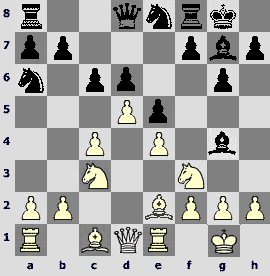
11...Ґd7. Six year ago Epishin won another remarkable game in this line. His opponent Cebalo proceeded with 11...c5 12.g3 ¤ac7. After 13.¤h4 the bishops were exchanged 13...Ґxe2 14.Јxe2. The game continued 14...¦b8 15.¤g2 a6 16.a4 b6 17.Ґd2 Јd7 18.¦f1 f5 19.exf5 gxf5 20.f4 e4, and here White got a strong initiative, undertaking a break on the kingside – 21.g4! fxg4 22.f5! ¦xf5 23.¦xf5 Јxf5 24.¦f1 Јd7 25.¤xe4. The threat ¤h4-f5 is fairly unpleasant, while Black`s rook and knight stuck on the queenside and it is hard to tell how to free them up. 18...b5 with counterplay was the most interesting choice.
12.a3. Vladimir tested the plan associated with exchanging on с6 and creating active pieces play, and also got a very good game – 12.dxc6 bxc6 (12...Ґxc6!?) 13.a3 ¤c5 14.Ґg5 f6 (14...Ґf6 has its own disadvantages: after 15.Ґe3 it blocks the f-pawn) 15.Ґe3 ¤e6 16.c5! ¤xc5 17.Ґxc5 dxc5 18.¤a4 ¤c7 19.¤xc5, Epishin-Reschke, Baunatal 2001. Our youth willing to learn countering the King`s Indian has an excellent role model!
12...c5. Otherwise one has to worry about dxc6 and b4. Now White can hardly achieve his queenside goals any soon, so he switches to the opposite side of the board, and takes various preventive measures against the opponent`s activity.
13.g3 f5 14.exf5 (not dangerous is 14.¤g5 ¤ac7) 14...gxf5 15.¤h4 ўh8. Ideally, Black`s attractive central pawns must advance in a crushing way, however, in this case both e5-e4 and f5-f4 gives White`s pieces gorgeous outposts. Thus the Cuban player makes a waiting move.
16.Ґd3 ¤ac7?! Black decides to bring the outlier piece into action, however, he should not forget that White has an advantage on the queenside by definition, so the knight could be useful for defensive purposes. Leaving aside these general considerations, it was important to notice White`s positional threat, and then Black could find the solution – 16...¤ec7, to meet 17.Јh5 by 17...Јe8. Curiously, preventing a check from g6 by natural 17...Ґe8? drops the f5-pawn due to 18.Јf3!, and 18...e4 is mistaken: 19.¤xe4! fxe4 20.Јxe4.

17.Јh5! ¤f6. The only defense against ¤g6 and ¤xf5. On 17...Јf6 White heats the situation up by 18.g4.
18.Јg5 ¤g4. 18...e4 19.Ґe2 can be safely called positional capitulation.
19.Јxd8 ¦axd8 20.Ґe2 ¤f6. The knight could be kept on g4 for some time. However, it does not bring any good, and calculating Ґxg4 fxg4, ¤e4 on every move is a bit tiring.
21.b4 ¤a6. After 21...b6 White would prepare opening the queenside by a4-a5.
22.¦b1. On 22.¤b5 Black plays 22...¤e8! Epishin follows the main course, not being distracted by trifles.
22...¤e8.
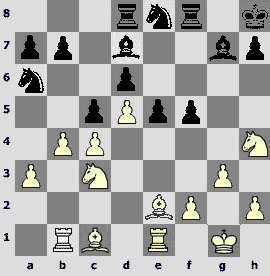
23.¦b3! An excellent maneuver: it supports the с3-knight and prepares Bb2.
23...Ґf6 24.¤g2 ¦g8 25.Ґb2 ¦g7 26.b5. Again showing great vision of the board! In case of 26...¤ac7 White will continue the queenside offensive – 27.b6 axb6 28.¦xb6, and the b7-pawn might fall. After the move actually played, the left side of the board starts stagnating, however, Vladimir correctly assessed that thanks to poor coordination of Black`s pieces, he will have an advantage on the kingside, too.
26...¤b8 27.¤d1 ¦e7? During the game you can always justify each of your moves (or at least those made in bright mind and moderate time-trouble). However, in retrospect it is easy to advise Black finding something better than moving his rook back and forth by f8-g8-g7-e7. Here, for instance, 27...Ґc8 planning ¤d7-f8 looks more attractive.
28.¤de3 ¤g7 29.f4.
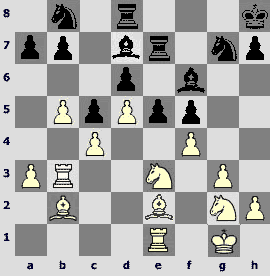
29...¦f8. White has enough resources to force е5-е4, so Black decides against postponing it.
30.¦f1 e4 31.Ґxf6 ¦xf6 32.h3 h5 33.g4! Another important stage of the plan is done.
33...hxg4. Probably, Black did not need to haste with this exchange. However, he hoped to use the h-file in his favor, and, in addition, it is difficult to foresee all the consequences of g4-g5 – what if some odd moves like ¤h4 win material at once? White can also delay moving the g-pawn for a while. So, Black has serious psychological problems.
34.hxg4 ¦h6. Not better is 34...fxg4 35.¤xg4 Ґxg4 (35...¦g6? 36.¤h4! ¦xg4+ 37.Ґxg4 Ґxg4 38.¤g6+) 36.Ґxg4 ¦g6 (36...¦h6 37.¦e1 leads to problems with the e4-pawn) 37.¦h3+ ўg8 38.Ґc8!
35.g5 ¦h3 36.ўf2 ¤e8. After 36...ўg8 37.¦bb1 the open file falls into White`s hands, however the text-move has a tactical flaw.

37.¤xf5! Ґxf5. Black is dead lost after 37...¦xb3 38.¤xe7.
38.¦xh3+ Ґxh3 39.¦h1 ¦h7 40.g6 ¦h6.

41.Ґg4! The combination was not made for a meek 41.ўg3? ¦xg6+ 42.ўxh3 ¦h6+ 43.¤h4 ¤d7.
41...Ґxg4 42.¦xh6+ ўg8 (42...ўg7 loses instantly to 43.¦h7+ ўxg6 44.¦xb7) 43.¤e3. On 43.¦h7 Black defends by 43...¤g7, preparing to attack the g6-pawn with the bishop. Now after 43...Ґc8 44.¦h7 ¤g7 it is out of danger, and White can send his king forward safely.
43...¤f6 44.ўg3 Ґc8 45.ўh4 ўg7 46.ўg5. The knight that stuck on b8 in ancient times still cannot return into play – and there is always a reason. This time it is the bishop that must guard the f5-square.
46...b6 47.a4. Hinting that rook is a very mobile piece, which can be thrown to the queenside after a4-a5.
47...a5.
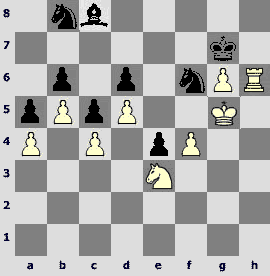
48.¦h8! Another small combination of the big player, and the White`s king has a free go to Black`s pawns left without support. The rest of the game does not require clarification.
48...ўxh8 49.ўxf6 ўg8 50.ўe7 ўg7 51.f5 Ґxf5 52.¤xf5+ ўxg6 53.¤e3 ўg5 54.ўxd6 ўf4 55.¤c2. Black resigned.
